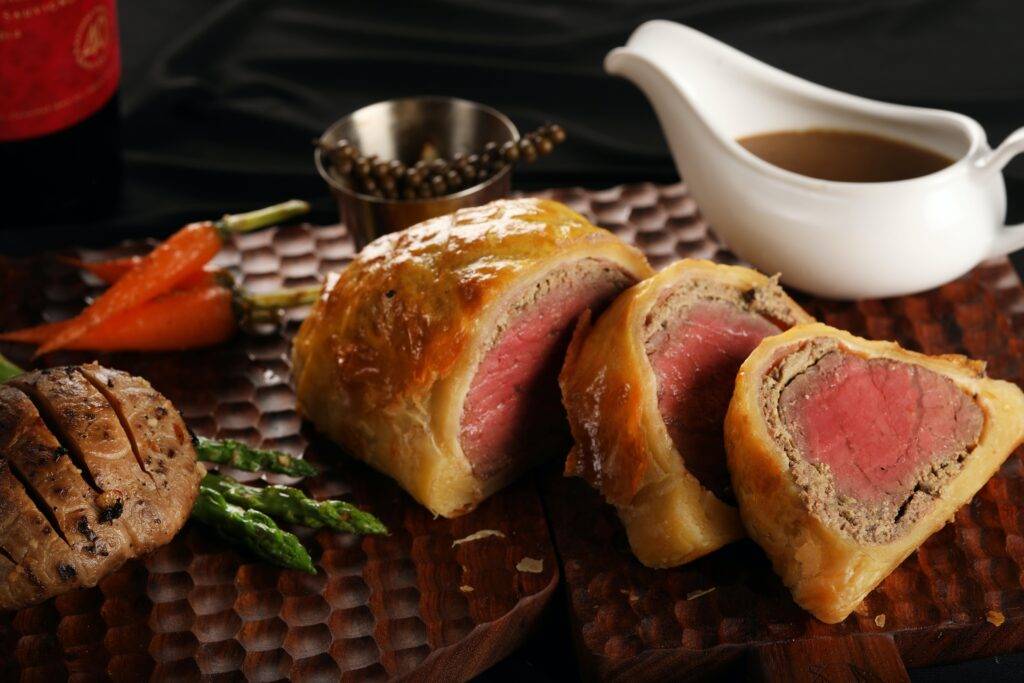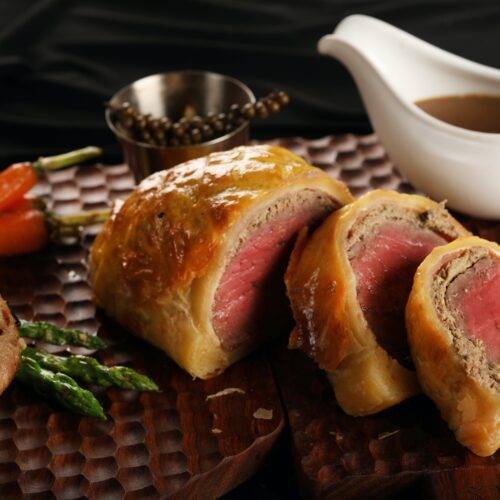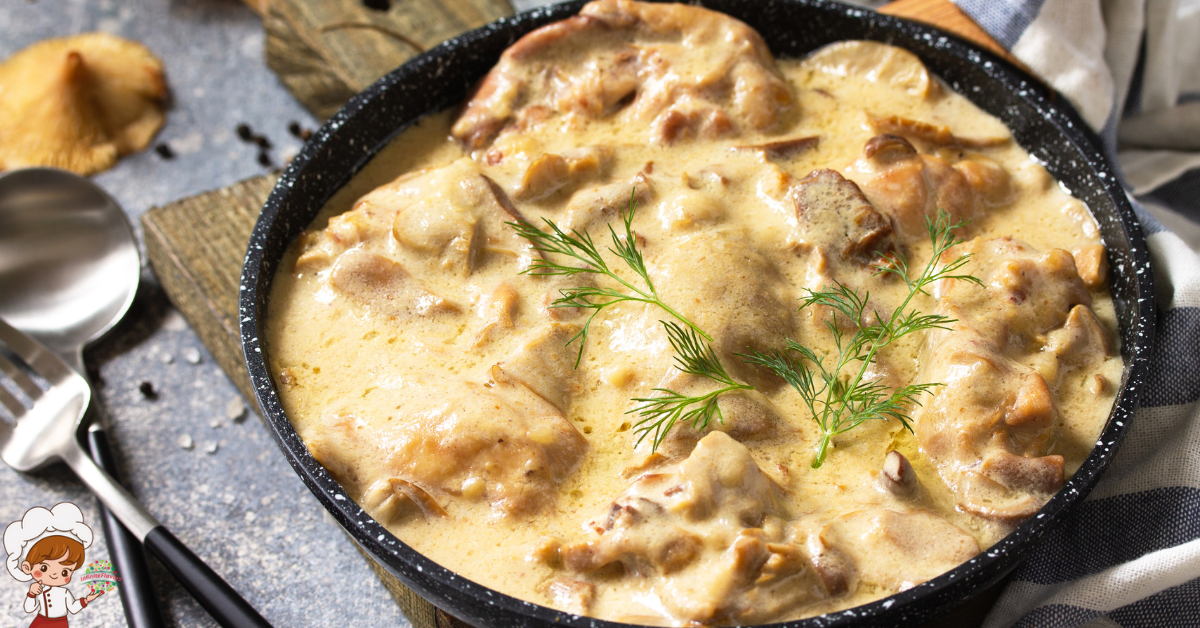Beef Wellington: An Amazing Masterpiece

Beef Wellington, a dish that exudes elegance and sophistication, has a history as rich and layered as its puff pastry wrapping. This culinary masterpiece has become a symbol of lavish dining, and its origins trace back to a blend of creativity, tradition, and a touch of British ingenuity.
The Birth of a Classic:
In the annals of culinary history, the genesis of Beef Wellington remains shrouded in a delightful air of mystery. While there is consensus that the dish emerged in 19th-century Britain, pinpointing its exact origin and the genius behind its creation is akin to unraveling a delicious enigma.
One prevailing theory attributes the birth of Beef Wellington to the Duke of Wellington, Arthur Wellesley, a prominent military and political figure of his time. According to this narrative, the dish was crafted to celebrate Wellington’s triumphant victory over Napoleon at the Battle of Waterloo in 1815. The idea was to create a culinary monument that mirrored the grandeur and opulence associated with the Duke himself.
The central components of Beef Wellington – succulent beef tenderloin, rich mushroom duxelles, foie gras (or sometimes pâté), all encased in a flaky puff pastry – were envisioned not merely as a meal but as a gastronomic homage to the Duke’s military triumph. The elegant and labor-intensive preparation, with its layers of flavors and textures, aimed to encapsulate the essence of a victorious era in a dish fit for nobility.
However, it’s crucial to note that historical accounts are often flavored with anecdotal nuances, and alternative stories about the dish’s creation abound. Some attribute the origin to French culinary influences, citing similar dishes like “filet de bœuf en croûte” that predate the Beef Wellington. Others believe it to be a reinterpretation of earlier English recipes, showcasing the evolutionary nature of culinary arts.
Regardless of its precise origins, the birth of Beef Wellington marked the inception of a culinary icon. Its journey from noble celebrations to global recognition showcases not only the versatility of its components but also the enduring appeal of a dish that seamlessly marries decadence with tradition. As we delve into the birth of this classic, let us savor the layers of history and craftsmanship that continue to make Beef Wellington a revered masterpiece on dining tables around the world.
Evolution and Popularization:
Beef Wellington’s early iterations featured simpler ingredients, often veal instead of beef, and a pastry crust designed to preserve the meat’s juices. Over time, the dish evolved, with mushroom duxelles and foie gras becoming integral components. The refinement of Beef Wellington mirrored the culinary advancements of the Victorian era, showcasing the influence of French haute cuisine.
Culinary Technique:
Central to Beef Wellington’s allure is its intricate preparation. The process involves searing a high-quality beef fillet, smearing it with a luxurious layer of mushroom duxelles, and wrapping it in prosciutto before encasing it in buttery puff pastry. The result is a symphony of flavors and textures – the tender beef, earthy mushrooms, and flaky pastry create a harmonious blend that delights the palate.
Popularity Across Continents:
Beef Wellington’s popularity transcended British borders, finding its way onto upscale menus around the world. The dish’s reputation for opulence made it a centerpiece for festive occasions and celebratory feasts. Despite its complex preparation, Beef Wellington became a symbol of culinary prowess, with chefs worldwide adding their unique twists to the classic recipe.

Beef Wellington
Ingredients
- 1 3- pound beef tenderloin trimmed
- Salt and freshly ground black pepper to taste
- 2 tablespoons olive oil
- 1 pound cremini or button mushrooms finely chopped
- 4 cloves garlic minced
- 2 tablespoons fresh thyme leaves chopped
- 1 cup dry white wine
- 8 ounces foie gras or pâté optional
- Dijon mustard for brushing
- 1 pound puff pastry thawed if frozen
- 2 large eggs beaten (for egg wash)
Instructions
- Preheat the oven to 425°F (220°C).
- Season the beef tenderloin generously with salt and pepper.
- In a large skillet, heat olive oil over high heat. Sear the beef on all sides until browned. Remove and let it cool.
- Mushroom Duxelles:
- In the same skillet, add chopped mushrooms, garlic, and thyme. Cook until the mushrooms release their moisture and become golden.
- Pour in the white wine, scraping any browned bits from the bottom. Continue cooking until the liquid evaporates. Allow the mushroom mixture to cool.
- Assembling:
- Roll out the puff pastry on a floured surface to a size that will cover the beef.
- If using foie gras or pâté, spread it over the cooled beef. Then, spread the mushroom mixture over the foie gras or pâté.
- Brush the beef with Dijon mustard.
- Place the beef in the center of the puff pastry and wrap it, sealing the edges. Brush the pastry with the beaten eggs.
- Baking:
- Transfer the wrapped beef to a baking sheet.
- Bake in the preheated oven for about 25–30 minutes or until the pastry is golden brown.
- For medium-rare beef, aim for an internal temperature of 130°F (54°C). Adjust the cooking time based on your desired doneness.
- Resting and Serving:
- Allow the Beef Wellington to rest for 10 minutes before slicing.
- Serve the slices on plates, showcasing the layers of mushroom duxelles, flaky pastry, and succulent beef.
- Optional Wine Sauce:
- For an extra touch, make a red wine reduction sauce by deglazing the mushroom skillet with red wine, then simmering until reduced. Drizzle over the sliced Beef Wellington.
Cultural Significance:
Beyond its reputation as a delicious and visually stunning dish, Beef Wellington carries cultural significance. Its association with grand celebrations and formal dining reflects an era when elaborate dinner parties were common. Today, Beef Wellington remains a showstopper, gracing tables during holidays and special occasions, preserving a tradition that spans centuries.
Conclusion: Beef Wellington
As we bid adieu to our exploration of Beef Wellington, we find ourselves immersed in the time-honored elegance and refined tastes that this culinary masterpiece bestows upon those who indulge. Beyond its exquisite layers of beef, mushroom duxelles, and golden puff pastry lies a narrative woven with threads of history, culinary evolution, and global acclaim.
Beef Wellington, with its enigmatic origin and sophisticated preparation, has become more than just a dish; it’s a celebration of gastronomic artistry. Its journey from the dining tables of 19th-century Britain to the global culinary stage is a testament to the enduring appeal of meticulously crafted cuisine.
As you embark on your own gastronomic adventure with Beef Wellington, whether recreating it in your kitchen or experiencing it in a fine-dining setting, take a moment to savor not just the flavors but the story encapsulated within each bite. Let the layers of tradition and innovation transport you to an era of culinary sophistication, and may the legacy of Beef Wellington continue to grace tables and captivate palates for generations to come.








